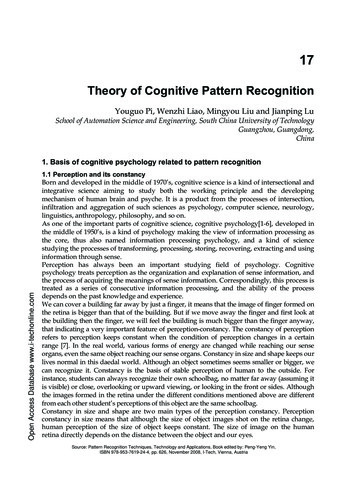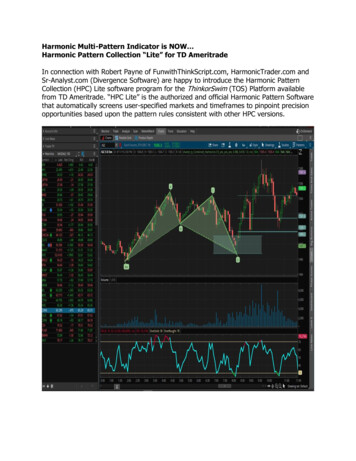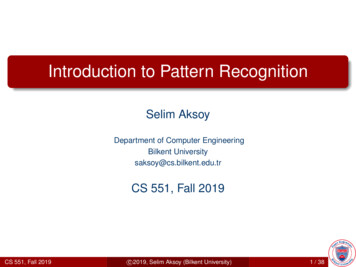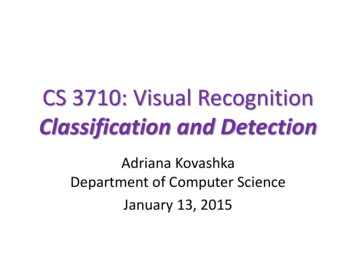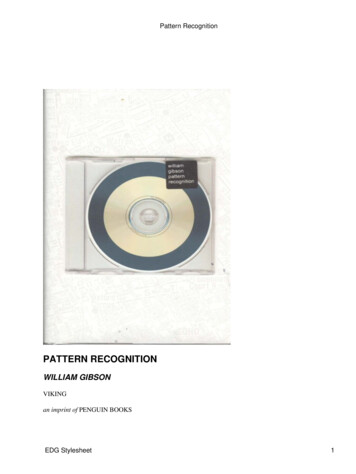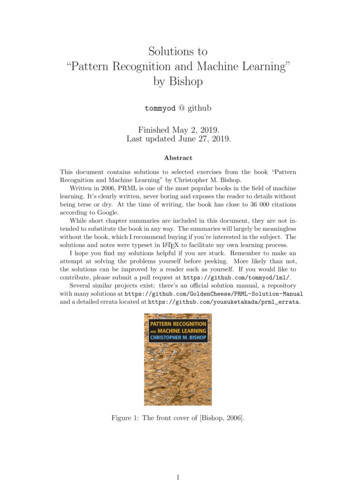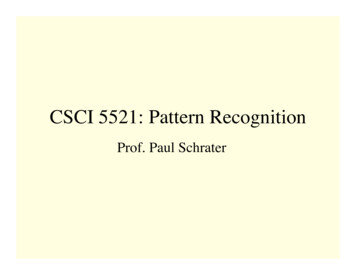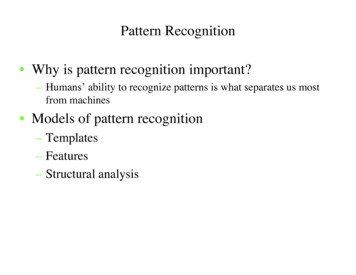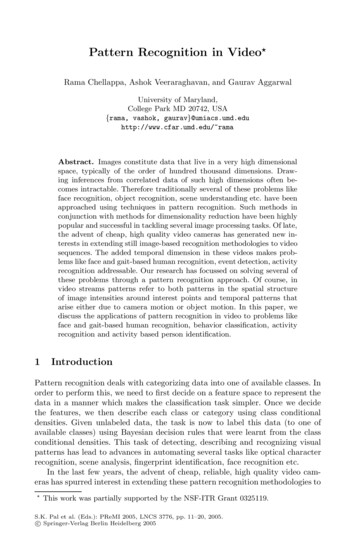
Transcription
Pattern Recognition in Video Rama Chellappa, Ashok Veeraraghavan, and Gaurav AggarwalUniversity of Maryland,College Park MD 20742, USA{rama, vashok, gaurav}@umiacs.umd.eduhttp://www.cfar.umd.edu/ ramaAbstract. Images constitute data that live in a very high dimensionalspace, typically of the order of hundred thousand dimensions. Drawing inferences from correlated data of such high dimensions often becomes intractable. Therefore traditionally several of these problems likeface recognition, object recognition, scene understanding etc. have beenapproached using techniques in pattern recognition. Such methods inconjunction with methods for dimensionality reduction have been highlypopular and successful in tackling several image processing tasks. Of late,the advent of cheap, high quality video cameras has generated new interests in extending still image-based recognition methodologies to videosequences. The added temporal dimension in these videos makes problems like face and gait-based human recognition, event detection, activityrecognition addressable. Our research has focussed on solving several ofthese problems through a pattern recognition approach. Of course, invideo streams patterns refer to both patterns in the spatial structureof image intensities around interest points and temporal patterns thatarise either due to camera motion or object motion. In this paper, wediscuss the applications of pattern recognition in video to problems likeface and gait-based human recognition, behavior classification, activityrecognition and activity based person identification.1IntroductionPattern recognition deals with categorizing data into one of available classes. Inorder to perform this, we need to first decide on a feature space to represent thedata in a manner which makes the classification task simpler. Once we decidethe features, we then describe each class or category using class conditionaldensities. Given unlabeled data, the task is now to label this data (to one ofavailable classes) using Bayesian decision rules that were learnt from the classconditional densities. This task of detecting, describing and recognizing visualpatterns has lead to advances in automating several tasks like optical characterrecognition, scene analysis, fingerprint identification, face recognition etc.In the last few years, the advent of cheap, reliable, high quality video cameras has spurred interest in extending these pattern recognition methodologies to This work was partially supported by the NSF-ITR Grant 0325119.S.K. Pal et al. (Eds.): PReMI 2005, LNCS 3776, pp. 11–20, 2005.c Springer-Verlag Berlin Heidelberg 2005
12R. Chellappa, A. Veeraraghavan, and G. Aggarwalvideo sequences. In video sequences, there are two distinct varieties of patterns.Spatial patterns correspond to problems that were addressed in image based pattern recognition methods like fingerprint and face recognition. These challengesexist in video based pattern recognition also. Apart from these spatial patterns,video also provides us access to rich temporal patterns. In several tasks like activity recognition, event detection/classification, anomaly detection, activity basedperson identification etc, there exists a temporal sequence in which various spatial patterns present themselves. It is very important to capture these temporalpatterns in such tasks. In this paper, we describe some of the pattern recognitionbased approaches we have employed for tasks including activity recognition, facetracking and recognition, anomaly detection and behavior analysis.2Feature RepresentationIn most pattern recognition (PR) problems, feature extraction is one of themost important tasks. It is very closely tied to pattern representation. It isdifficult to achieve pattern generalization without using a reasonably correctrepresentation. The choice of representation not only influences the PR approachto a great extent, but also limits the performance of the system, depending uponthe appropriateness of the choice. For example, one cannot reliably retrieve theyaw and pitch angles of a face assuming a planar model.Depending on the problem at hand, the representation itself can manifest inmany different ways. Though in the case of still images, only spatial modelingis required, one needs ways to represent temporal information also when dealingwith videos. At times, the representation is very explicit like in the form of ageometric model. On the other hand, in a few feature based PR approaches,the modeling part is not so explicit. To further highlight the importance ofrepresentation, we now discuss the modeling issues related to a few problems invideo-based recognition.2.1Affine Appearance Model for Video-Based RecognitionRecognition of objects in videos requires modeling object motion and appearancechanges. This makes object tracking a crucial preceding step for recognition. Inconventional algorithms, the appearance model is either fixed or rapidly changing, while the motion model is a random walk model with constant variance.A fixed appearance template is not equipped to handle appearance changes inthe video, while a rapidly changing model is susceptible to drift. All these factors can potentially make the visual tracker unstable leading to poor recognitionresults. In [1], we use adaptive appearance and velocity models to stabilize thetracker and closely follow the variations in appearance due to object motion. Theappearance is modeled as a mixture of three different models, viz., (1) objectappearance in a canonical frame (first frame), (2) slow-varying stable appearance within all the past observation, and (3) the rapidly changing componentcharacterizing the two-frame variations. The mixture probabilities are updatedat each frame based on the observation. In addition, we use an adaptive-velocity
Pattern Recognition in Video13Fig. 1. Affine appearance model for trackingmodel, where the adaptive velocity is predicted using a first-order linear approximation based on appearance changes between the incoming observation and theprevious configuration.The goal here is to identify a region of interest in each frame of the videoand not the 3D location of the object. Moreover, we believe that the adaptiveappearance model can easily absorb the appearance changes due to out-of-planepose and illumination changes. Therefore, we use a planar template and allow affine transformations only. Fig. 1 shows an example where tracker usingthe described representation is used for tracking and recognizing a face in avideo.2.23D Feature GraphsAffine model suffices for locating the position of the object on the image, but itdoes not have the capability to annotate the 3D configuration of the object ateach time instant. For example, if the goal is to utilize 3D information for facerecognition in video, the described affine representation will not be adequate.Accordingly, [2] uses a cylindrical model with elliptic cross-section to perform3D face tracking and recognition. The curved surface of the cylinder is dividedinto rectangular grids and the vector containing the average intensity values foreach of the grids is used as the feature. As before, appearance model is a mixtureof the fixed component (generated from the first frame) and dynamic component(appearance in the previous frame). Fig. 2 shows a few frames of a video withthe cylinder superimposed on the image displaying the estimated pose.Fig. 2. Estimated 3D pose of a face using a cylindrical model for face recognition invideosAnother possibility is to consider using a more realistic face model (e.g., 3Dmodel of an average face) instead of a cylinder. Such detailed 3D representations make the initialization and registration process difficult. In fact, [3] showsexperiments where perturbations in the model parameters adversely affect thetracking performance using a complex 3D model, whereas the simple cylindricalmodel is robust to such perturbations. This highlights the importance of thegeneralization property of the representation.
142.3R. Chellappa, A. Veeraraghavan, and G. AggarwalRepresentations for Gait-Based RecognitionGait is a very structured activity with certain states like heel strike, toe off repeating themselves in a repetitive pattern. Recent research suggests that the gaitof an individual might be distinct and therefore can be used as a biometric forperson identification. Typical representations for gait-based person identificationinclude use of the entire binary silhouette [4][5], sparser representations like thewidth vector [5] or shape of the outer contour [6]. 3D part based descriptions ofhuman body [7] is also a viable representation for gait analysis.2.4Behavior Models for Tracking and RecognitionStatistical modeling of the motion of the objects enables us to capture the temporal patterns in video. Modeling such behaviors explicitly is helpful in accurateand robust tracking. Typically each object could display multiple behaviors. Weuse Markovian models (on low level motion states) to represent each behaviorof the object. This creates a mixture modeling framework for the motion of theobject. For illustration, we will discuss the manner in which we modeled thebehavior of insects for the problem of tracking and behavior analysis of insects.A typical Markov model for a special kind of dance of a foraging bee called thewaggle dance is shown in Fig. 3.AbdomenThoraxx3x4*(x1,x2)x5HeadShape model for trackingEPHASBehavior model for Activity 250.250.340.343A foraging bee executing a waggle dance0.66WaggleTurn40.660.34Fig. 3. A Bee performing waggle dance: The Shape model for tracking and the Behaviormodel to aid in Activity analysis are also shown3Particle Filtering for Object Recognition in VideoWe have so far dealt with issues concerned with the representation of patternsin video and dealt with how to represent both spatial and temporal patterns ina manner that simplifies identification of these patterns. But, once we choosea certain set of representations for spatial and motion patterns, we need inference algorithms for estimating these parameters. One method to perform thisinference is to cast the problem of estimating the parameters as a energy minimization problem and use popular methods based on variational calculus forperforming this energy minimization. Examples of such methods include gradient descent, simulated annealing, deterministic annealing and ExpectationMaximization. Most such methods are local and hence are not guaranteed to
Pattern Recognition in Video15converge to the global optimum. Simulated annealing is guaranteed to converge to the global optimum if proper annealing schedule is followed but thismakes the algorithm extremely slow and computationally intensive. When thestate-observation description of the system is linear and Gaussian, estimatingthe parameters can be performed using the Kalman filter. But the design ofKalman filter becomes complicated for intrinsically non-linear problems and isnot suited for estimating posterior densities that are non-Gaussian. Particle filter [8][9] is a method for estimating arbitrary posterior densities by representingthem with a set of weighted particles. We will precisely state the estimationproblem first and then show how particle filtering can be used to solve suchproblems.3.1Problem StatementConsider a system with parameters θ. The system parameters follow a certaintemporal dynamics given by Ft (θ, D, N ). (Note that the system dynamics couldchange with time.)SystemDynamics :θt Ft (θt 1 , Dt , Nt )(1)where, N is the noise in the system dynamics. The auxiliary variable D indexesthe set of motion models or behaviors exhibited by the object and is usuallyomitted in typical tracking applications. This auxiliary variable assumes importance in problems like activity recognition or behavioral analysis (Section 4.3).Each frame of the video contains pixel intensities which act as partial observations Z of the system state θ.ObservationEquation :Zt G(θt , I, Wt )(2)where, W represents the observation noise. The auxiliary variable I indexes thevarious object classes being modeled, i.e., it represents the identity of the object.We will see an example of the use of this in Section4.The problem of interest is to track the system parameters over time as andwhen the observations are available. Quantitatively, we are interested in estimating the posterior density of the state parameters given the observations i.e.,P (θt /Z1:t ).3.2Particle FilterParticle filtering [8][9] is an inference technique for estimating the unknown dynamic state θ of a system from a collection of noisy observations Z1:t . The particlefilter approximates the desired posterior pdf p(θt Z1:t ) by a set of weighted par(j)(j)ticles {θt , wt }Mj 1 , where M denotes the number of particles. The interestedreader is encouraged to read [8][9] for a complete treatment of particle filtering.The state estimate θˆt can be recovered from the pdf as the maximum likelihood(ML) estimate or the minimum mean squared error (MMSE) estimate or anyother suitable estimate based on the pdf.
163.3R. Chellappa, A. Veeraraghavan, and G. AggarwalTracking and Person IdentificationConsider a gallery of P objects. Supposing the video contains one of these Pobjects. We are interested in tracking the location parameters θ of the objectand also simultaneously recognize the identity of the object. For each object i,the observation equation is given by Zt G(θt , i, Wt ). Suppose we knew thatwe are tracking the pth object, then, as usual, we could do this with a particlefilter by approximating the posterior density P (θt /Z1:t , p) as a set of M weighted(j)(j)particles {θt , wt }Mj 1 . But, if we did not know the identity of the object weare tracking, then, we need to estimate the identity of the object also. Let usassume that the identity of the object remains the same throughout the video,i.e., It p, where p {1, 2, .P }. Since the identity remains a constant overtime, we haveP (Xt , It i/Xt 1 , It 1 j) P (Xt /Xt 1 )P (It i/It 1 j) (3)0if i j;P (Xt /Xt 1 ) if i j; j {1, 2, .P }As was discussed in the previous section, we can approximate the posterior den(j)(j)sity P (Xt , I p/Z1:t ) using a Mp weighted particles as {θt,p , wt,p }j 1:Mp . Wemaintain such a set of Mp particles for each object p 1, 2, .P . Now the set (j)(j)of weighted particles {θt,p , wt,p }p 1:Pp 1:Pj 1:Mij 1:Mp with weights such that(j)wt,p 1, represents the joint distribution P (θt , I/Z1:t ). MAP and MMSE estimates for the tracking parameters θˆt can be obtained by marginalizing the distribution P (θt , I/Z1:t ) over the identity variable. Similarly, the MAP estimate forthe identity variable can be obtained by marginalizing the posterior distributionover the tracking parameters. Refer to [10] for the details of the algorithm andthe necessary and sufficient conditions for which such a model is valid.3.4Tracking and Behavior IdentificationSimultaneous tracking and behavior/activity analysis can also be performed ina similar manner by using the auxiliary variable D in a manner very similar toperforming simultaneous tracking and verification. Refer to [11] for details about(j)(j)(j)the algorithm. Essentially, a set of weighted particles {θt , wt , Dt } is used torepresent the posterior probability distribution P (θt , Dt /Z1:t ). Inferences aboutthe tracking parameters θt and the behavior exhibited by the object Dt can bemade by computing the relevant marginal distribution from the joint posteriordistribution. Some of the tracking and behavior analysis results for the problemof analyzing the behaviors of bees in a hive are given in a later section.4Pattern Recognition in Video: Working ExamplesIn this section, we describe a few algorithms to tackle video-based pattern recognition problems. Most of these algorithms make use of the material described sofar in this paper, in some form or the other.
Pattern Recognition in Video4.117Visual Recognition Using Appearance-Adaptive ModelsThis work [10] proposes a time series state space model to fuse temporal information in a video, which simultaneously characterizes the motion and identity. Asdescribed in the previous section, the joint posterior distribution of the motionvector and the identity variable is estimated at each time instant and then propagated to the next time instant. Marginalization over the motion state variablesyields a robust estimate of the posterior distribution of the identity variable. Themethod can be used for both still-to-video and video-to-video face recognition. Inthe experiments, we considered only affine transformations due to the absence ofsignificant out-of-plane rotations. A time-invariant first-order Markov Gaussianmodel with constant velocity is used for modeling motion transition. Fig. 4 showsthe tracking output in a outdoor video. [1] incorporates appearance-adaptivemodels in a particle filter to perform robust visual tracking and recognition. Appearance changes and changing motion is handled adaptively in the manner asdescribed in Section 2.1. The simultaneous recognition is performed by includingthe identity variable in the state vector as described in Section 3.3.Fig. 4. Example tracking results using the approach in [10]4.2Gait-Based Person IdentificationIn [12], we explored the use of the width vector of the outer contour of thebinarized silhouette as a feature for gait representation. Matching two sequencesof width vectors was performed using the Dynamic Time Warping (DTW). TheDTW algorithm is based on dynamic programming and aligns two sequences bycomputing the best warping path between the template and the test sequence. In[5], the entire binary image of the silhouette is used as a feature. The sequence ofbinary silhouette images were modeled using a Hidden Markov Model (HMM).States of the HMM were found to represent meaningful physical stances like heelstrike, toe off etc. The observation probability of a test sequence was used as ametric for recognition experiments. Results using both the HMM and DTW werefound to be comparable to the state of the art gait-based recognition algorithms.Refer to [12] and [5] for details of the algorithms.4.3Simultaneous Tracking and Behavior Analysis of InsectsIn [11], we present an approach that will assist researchers in behavioral research study and analyze the motion and behavior of insects. The system must
18R. Chellappa, A. Veeraraghavan, and G. Aggarwalalso be able to detect and model abnormal behaviors. Such an automated system significantly speeds up the analysis of video data obtained from experiments and also prevents manual errors in the labeling of data. Moreover, parameters like the orientation of the various body parts of the insects(which isof great interest to the behavioral researcher) can be automatically extractedin such a framework. Each behavior of the insect was modeled as a Markovprocess on low-level motion states. The transition between behaviors was modeled as another Markov process. Simultaneous tracking and behavior analysis/identification was performed using the techniques described in Section 3.4.Bees were modeled using an elliptical model as shown in Fig. 3. Three behaviorsof bees Waggle Dance, Round Dance and Hovering bee were modeled. Deviations from these behaviors were also identified and the model parameters forthe abnormal behaviors were also learnt online. Refer [11] for the details of theapproach.4.4Activity Recognition by Modeling Shape SequencesHuman gait and activity analysis from video is presently attracting a lot of attention in the computer vision community. [6] analyzed the role of two of themost important cues in human motion- shape and kinematics using a patternrecognition approach. We modeled the silhouette of a walking person as a sequence of deforming shapes and proposed metrics for comparing two sequences ofshapes using a modification of the Dynamic Time Warping algorithm. The shapesequences were also modeled using both autoregressive and autoregressive andmoving average models. The theory of subspace angles between linear dynamicalsystems was used to compare two sets of models. Fig. 5 depicts a graphical visualization of performing gait recognition by comparing shape sequences. Referto [6] for the details of the algorithm and extended results.Fig. 5. Graphical illustration of the sequence of shapes obtained during gait
Pattern Recognition in Video4.519Activity Modeling and Anomaly DetectionIn the previous subsection, we described an approach for representing an activity as a sequence of shapes. But, when new activities are seen, then we needto develop approaches to detect these anomalous activities. The activity modelunder consideration is a continuous state HMM. An abnormal activity is defined as a change in the activity model, which could be slow or drastic andwhose parameters are unknown. Drastic changes can be easily detected usingthe increase in tracking error or the negative log of the likelihood of currentobservation given past (OL). But slow changes usually get missed. [13] proposesa statistic for slow change detection called ELL (which is the Expectation ofnegative Log Likelihood of state given past observations) and shows analyticallyand experimentally the complementary behavior of ELL and OL for slow anddrastic changes. We have also established the stability (monotonic decrease) ofthe errors in approximating the ELL for changed observations using a particlefilter that is optimal for the unchanged system. Asymptotic stability is shownunder stronger assumptions. Finally, it is shown that the upper bound on ELLerror is an increasing function of the rate of change with increasing derivatives of all orders, and its implications are discussed. Fig. 6 shows the trackingerror, Observation likelihood and the ELL statistic for simulated observationnoise.Fig. 6. ELL, Tracking error (TE) and Observation Likelihood (OL) plots: SimulatedObservation noise. Notice that the TE and OL plots look alike.5ConclusionsWe have presented very brief descriptions of some of the approaches based onpattern recognition to various problems like tracking, activity modeling, behavior analysis and abnormality detection. The treatment in this paper is notcomprehensive and the interested readers are encouraged to refer the respectivereferences and references therein for details on each of these approaches.Acknowledgments. The authors thank Shaohua Zhou, Namrata Vaswani, AmitKale and Aravind Sundaresan for their contributions to the material presented inthis manuscript.
20R. Chellappa, A. Veeraraghavan, and G. AggarwalReferences1. Zhou, S., Chellappa, R., Moghaddam, B.: Visual tracking and recognition usingappearance-adaptive models in particle filters. IEEE Trans. on IP (2004)2. Aggarwal, G., Veeraraghavan, A., Chellappa, R.: 3d facial pose tracking in uncalibrated videos. Submitted to Pattern Recognition and Machine Intelligence (2005)3. Cascia, M.L., Sclaroff, S., Athitsos, V.: Fast, reliable head tracking under varyingillumination: An approach based on registration of texture-mapped 3D models.IEEE Trans. on Pattern Analysis and Machine Intelligence 22 (2000) 322–3364. Lee, L., Dalley, G., Tieu, K.: Learning pedestrian models for silhouette refinement.IEEE International Conference on Computer Vision 2003 (2003)5. Kale, A., Rajagopalan, A., Sundaresan.A., Cuntoor, N., Roy Cowdhury, A.,Krueger, V., Chellappa, R.: Identification of humans using gait. IEEE Trans.on Image Processing (2004)6. Veeraraghavan, A., Roy-Chowdhury, A., Chellappa, R.: Role of shape and kinematics in human movement analysis. CVPR 1 (2004) 730–7377. Yamamoto, T., Chellappa, R.: Shape and motion driven particle filtering for humanbody tracking. Intl. Conf. on Multimedia and Expo (2003)8. Doucet, A., Freitas, N.D., Gordon, N.: Sequential Monte Carlo methods in practice.Springer-Verlag, New York (2001)9. Gordon, N.J., Salmond, D.J., Smith, A.F.M.: Novel approach to nonlinear/nongaussian bayesian state estimation. In: IEE Proceedings on Radar and SignalProcessing. Volume 140. (1993) 107–11310. Zhou, S., Krueger, V., Chellappa, R.: Probabilistic recognition of human facesfrom video. Computer Vision and Image Understanding 91 (2003) 214–24511. Veeraraghavan, A., Chellappa, R.: Tracking bees in a hive. Snowbird LearningWorkshop (2005)12. Kale, A., Cuntoor, N., Yegnanarayana, B., Rajagopalan, A., Chellappa, R.: Gaitanalysis for human identification. 3rd Intl. conf. on AVBPA (2003)13. Vaswani, N., Roy-Chowdhury, A., Chellappa, R.: Shape activity: A continuousstate hmm for moving/deforming shapes with application to abnormal activitydetection. IEEE Trans. on Image Processing (Accepted for Publication)
Pattern recognition deals with categorizing data into one of available classes. In order to perform this, we need to first decide on a feature space to represent the data in a manner which makes the classification task simpler. Once we decide . filter ap
